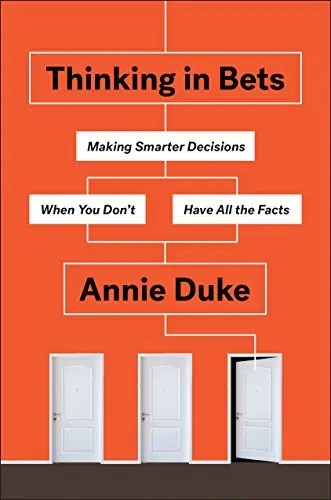I learned a lot about decision making under uncertainty from Annie Duke’s new book, Thinking in Bets: Making Smarter Decisions When You Don’t Have All the Facts.
Annie first mastered decision making in the field of poker. She won a World Series of Poker gold bracelet, the World Series of Poker Tournament of Champions, and the NBC National Heads-Up Championship, and earned more than $4 million in tournament winnings.

It turns out, her approach to making decisions at the poker table translates into making decisions in business and life. In poker, you don’t know what cards your opponents are holding and you can’t predict how they will act or what cards will draw next. Similarly, in most aspects of life, you don’t have all the information you need to make a decision and it’s impossible to predict the future with perfect accuracy.
That’s what Annie’s book is all about: Estimating the probability of different futures and making decisions, or “bets”, accordingly.
Decision making under uncertainty is critical because, as Annie says in the introduction of her book, “there are exactly two things that determine how our lives turn out: the quality of our decisions and luck.”
Here are 16 lessons I learned on improving decision making under uncertainty.
1. The relationship between decision quality and outcome is loose
The outcome of every decision you make provides feedback on your decision making process. However, when you are making decisions under uncertainty – such as playing poker or starting a business – you inherently have limited information to work with, and there are a number of potential outcomes, each with different probabilities.
Therefore, “winning and losing are only loose signals of decision quality,” Annie says.
You can make the right decision given the information you have and still not achieve the desired result. And you can make a poor decision and get lucky.
2. Decisions are bets
It’s impossible to predict the future. It’s important to acknowledge that there’s some degree of uncertainty in almost every decision we make.
Treating decisions as bets, I discovered, helped me avoid common decision traps, learn from results in a more rational way, and keep emotions out of the process as much as possible.”
3. “Our bets are only as good as our beliefs”
We make decisions based on the information that we have and the beliefs that we develop as a result of that information. Therefore, it’s critical that we work to improve our beliefs if we want to make better decisions.
Part of the skill in life comes from learning to be a better belief calibrator, using experience and information to more objectively update our beliefs to more accurately represent the world. The more accurate our beliefs, the better the foundations of the bets we make.”
4. Our beliefs aren’t always accurate
“This is how we think we form abstract beliefs: (1) We hear something; (2) We think about it and vet it, determining whether it is true or false; only after that (3) We form our belief.
It turns out, though, that we actually form abstract beliefs this way: (1) We hear something; (2) We believe it to be true; (3) Only sometimes, later, if we have the time or the inclination, we think about it and vet it, determining whether it is, in fact, true or false.”
“Instead of altering our beliefs to fit into new information, we do the opposite, altering our interpretation of the information to fit our beliefs.”
These inaccurate thinking patterns happen because of a number of cognitive biases that Annie touches on in the book.
5. Our brains aren’t great at interpreting reality
These cognitive biases have benefit from an evolutionary perspective.
Our brains have built-in conflicts of interest, interpreting the world around us to confirm our beliefs, to avoid having to admit ignorance or error, to take credit for good results following our decisions, to find reasons for bad results following our decisions were due to factors outside of our control, to compare well with our peers, and to live in a world where the way things turn out make sense.”
6. Thinking in bets can improve your decision making
Annie describes the positive behaviors that result from thinking in terms of bets (probabilities):
We can get better at separating outcome quality from decision quality, discover the power of saying, ‘I’m not sure,’ learn strategies to map out the future, become less reactive decision-makers, build and sustain pods of fellow truth-seekers to improve our decision process, and recruit our past and future selves to make fewer emotional decisions.”
Thinking in bets gives you skin in the game motivates you to think about all possible outcomes. It forces you to ask questions such as “Why might my belief not be true?”, “What other evidence might be out there bearing on my belief?”, and “What are the reasons someone else could have a different belief, what’s their support, and why might they be right instead of me?”
Ultimately, “Thinking in bets embodies skepticism by encouraging us to examine what we do and don’t know and what our level of confidence is in our beliefs and predictions,” Annie writes.
7. We almost never have all the facts we need
“The decisions we make in our lives – in business, saving and spending, health and lifestyle choices, raising our children, and relationships – easily fit [John] von Neumann’s definition of ‘real games.’ They involve uncertainty, risk, and occasional deception, prominent elements in poker.”
We are going to do better, and be happier, if we start by recognizing that we’ll never be sure of the future. That changes our task from trying to be right every time, an impossible job, to navigating our way through the uncertainty by calibrating our beliefs to move towards, little by little, a more accurate and objective presentation of the world.”
8. Use uncertainty to your advantage
“I’m not sure” and “I don’t know” are often statements of fact, and can, therefore, help with decision making under uncertainty.
A great decision is the result of a good process, and that process must include an attempt to accurately represent our own state of knowledge.”
It’s ok if that knowledge is limited. “We have to make peace with not knowing,” Annie writes. It’s the first step to learning.
9. Measure your confidence
“We would be better served as communicators and decision-makers if we thought less about whether we are confident in our beliefs and more about how confident we are. Instead of thinking of confidence as all-or-nothing (‘I’m confident’ or ‘I’m not confident’), our expression of our confidence would then capture all the shades of grey in between.”
“Incorporating percentages or ranges of alternatives into the expression of our beliefs means that our personal narrative no longer hinges on whether we were wrong or right but on how well we incorporate new information to adjust the estimate of how accurate our beliefs are.”
10. Bet on the probability of different futures
“Improving decision quality is about increasing our chances of good outcomes, not guaranteeing them,” Annie writes.
She recommends thinking about all possible outcomes, estimating the probability of each outcome, and making a bet (decision) accordingly.
11. Don’t equate the quality of a decision with the quality of its outcome
You have control over the quality of your decisions. You don’t have full control over the outcomes of your decisions.
For example, a football coach can go for it on fourth down instead of punting, fail to achieve the first down, and still have made the correct decision. There are a few potential outcomes of going for it on fourth down (first down, interception, touchdown, etc.). Each one of those outcomes has a probability of being realized. The decision to go for it on fourth down may have been a good decision, even if it fails to achieve the desired result.
Resulting, assuming that our decision-making is good or bad based on a small set of outcomes, is a pretty reasonable strategy for learning in chess. But not in poker – or life.”
12. Don’t succumb to hindsight bias
According to Annie, “Hindsight bias is the tendency, after an outcome is known, to see the outcome as having been inevitable.”
If you have an overly tight connection between outcomes and decisions, you might succumb to this bias. In reality, you can only make an estimate about what will happen in the future – you can’t know with certainty.
13. Get feedback and update your beliefs
“Learning occurs when you get lots of feedback tied closely in time to decisions and actions.”
Annie recommends building a community or mastermind group to analyze decisions you have made or need to make.
14. Analyze decisions before the outcome is known
As discussed above, outcomes are not a good signal of decision quality. That’s why Annie recommends analyzing the quality of a decision before knowing the outcome.
Her poker mastermind group discussed the decision making process of a hand but often never shared the outcome of the hand. It doesn’t matter if you win or lose the hand. The decision making process is more important.
15. Time travel
We tend to favor our present-self at the expense of our future-self. For example, your present-self is happier if you push the snooze button on your alarm clock in the morning. However, your future-self will be happier if you get out of bed earlier to work on your side business.
“Bringing our future-self into the decision gets us started thinking about the future consequences of those in-the-moment decisions,” Annie says. Think about how your future-self will feel 2 years from now if you hit the snooze button.
16. Work backwards from the outcome
“Imagining a successful future and backcasting from there is a useful time-travel exercise for identifying necessary steps for reaching our goals.”
Imagining success can help you see all the things that you need to go right for your decision to work out. Imagining failure can also be helpful. It forces you to think about potential causes of failure and then find ways to solve for them.
These were my most impactful takeaways, but Thinking in Bets: Making Smarter Decisions When You Don’t Have All the Facts is packed with good strategies for decision making under uncertainty, a critical but commonly overlooked skill. I highly recommend buying the book and reading the whole thing.



